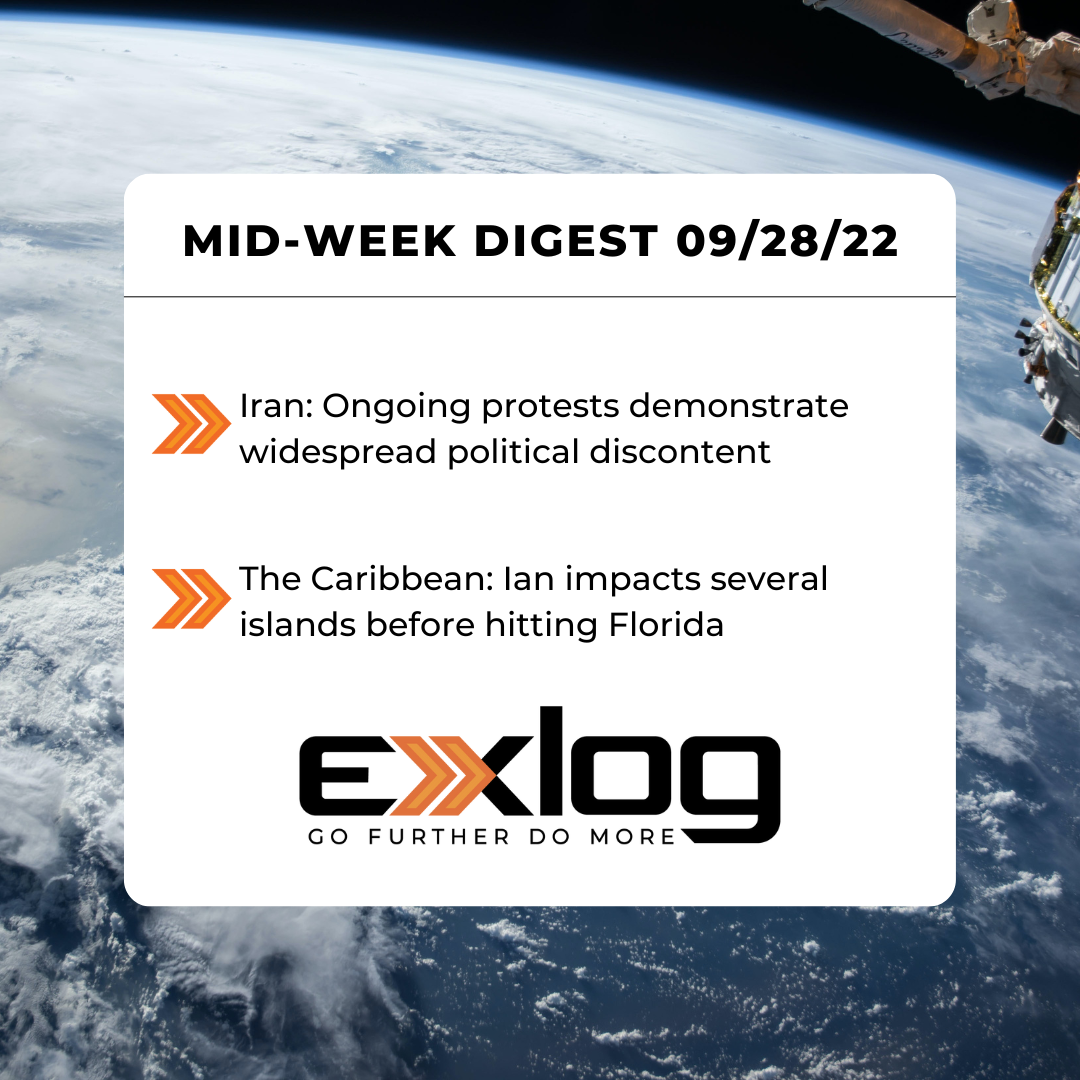Violent Anti-Government Protests in Iran and Major Hurricane Ian Strikes Cuba and Florida
Iran: Ongoing Protests Demonstrate Widespread Political Discontent
Nearly two weeks of sustained, anti-government protests in several Iranian cities have resulted in severe clashes with security forces, widespread travel disruptions, and telecommunications outages. The rallies erupted on Sept. 17 following the death of a Kurdish-Iranian woman in police custody after she was arrested for violating Tehran’s hijab mandate. While officials claim that the woman died of a heart attack, family members and human rights organizations have insisted that the victim succumbed to injuries inflicted by the police. The protests initially began in predominantly Kurdish regions in western Iran but have since spread to at least 46 cities and villages and transformed into a wider movement calling for the fall of the country’s clerical regime. Security forces have used live ammunition, tear gas, and pellet guns in an attempt to quell the demonstrations; Iranian state media has reported that at least 41 people – including seven members of the security forces – have been killed, and at least 1,200 others have been arrested since the protests began. As of Sept. 21, the government has restricted the use of online communication platforms and disrupted mobile internet services in order to limit expressions of political discontent and inhibit coordination of demonstrations. Although the protests were initially fueled by an isolated incident, their recent shift to encompass a broad range of related grievances – including the brutality of the state’s security forces and recent economic instability – indicates that the unrest is unlikely to subside in the short term in the absence of government concessions. The movement could expand even further if labor groups become involved; one of Iran’s main teachers’ unions called for a nationwide strike on Sept. 28, although the level of participation and implications of the work stoppage were not immediately clear due to communication disruptions across the country. Given the apparent momentum of the demonstrations, security forces are increasingly likely to intensify operations against protesters – which could in turn further inflame anti-government sentiment and lead to a significant deterioration of the security environment across the country.
The Caribbean: Ian Impacts Several Islands Before Hitting Florida
The effects of Hurricane Ian are likely to be felt across the southeastern US in the coming days as the storm makes landfall on Florida’s Gulf Coast on Sept. 28, prompting hurricane advisories, mandatory evacuations, and widespread transportation disruptions. As a Category 4 storm, Ian made landfall along the southwestern coast of Florida near Cayo Costa at around 1500 on Sept. 28 with maximum sustained winds of 150 mph (240 kph), bringing up to 24 inches (609 mm) of rain and triggering flash and river flooding, high storm surge, and possible tornadoes across central and south Florida. State Governor Ron DeSantis has declared a statewide state of emergency, ordering mandatory evacuations for coastal communities in 12 counties; the heavily populated Naples/Ft. Myers areas are at highest risk of a storm surge. Significant transportation disruptions were reported ahead of the storm; at least six international airports in the state had suspended operations as of Sept. 28, and many bridges along the coast are closed due to expected high winds. As the US prepares for Ian’s arrival, several other countries including Cuba, the Cayman Islands, Honduras, and Jamaica continue to recover from its effects. The hurricane initially made rainfall as a Category 3 storm in Cuba on Sept. 27, killing at least two people in Pinar del Rio province. In addition to widespread private property damage and travel disruptions, the storm decimated the country’s power grid, leaving more than 11 million people without electricity. According to the National Electric system, repair work is ongoing, although areas in the western region of the island that experienced the most destruction from the storm may experience restoration delays. Despite its location outside of the hurricane’s path, Honduras also experienced heavy rainfall and flooding that affected more than 19,000 people. According to the Honduran authorities, the storm damaged or destroyed at least 266 homes, in addition to several bridges and roads. Depending on the level of destruction Hurricane Ian brings to homes, businesses, and infrastructure in Florida, similar recovery efforts are expected in that state; according to Governor DeSantis, 30,000 linemen and 7,000 National Guard troops will be assisting urban search and rescue teams in the aftermath of the storm. The National Hurricane Center (NHC) forecasts that Ian will weaken after making landfall, although heavy rains and flooding are expected in northeast Florida, southeastern Georgia, and coastal South Carolina in the coming days.


